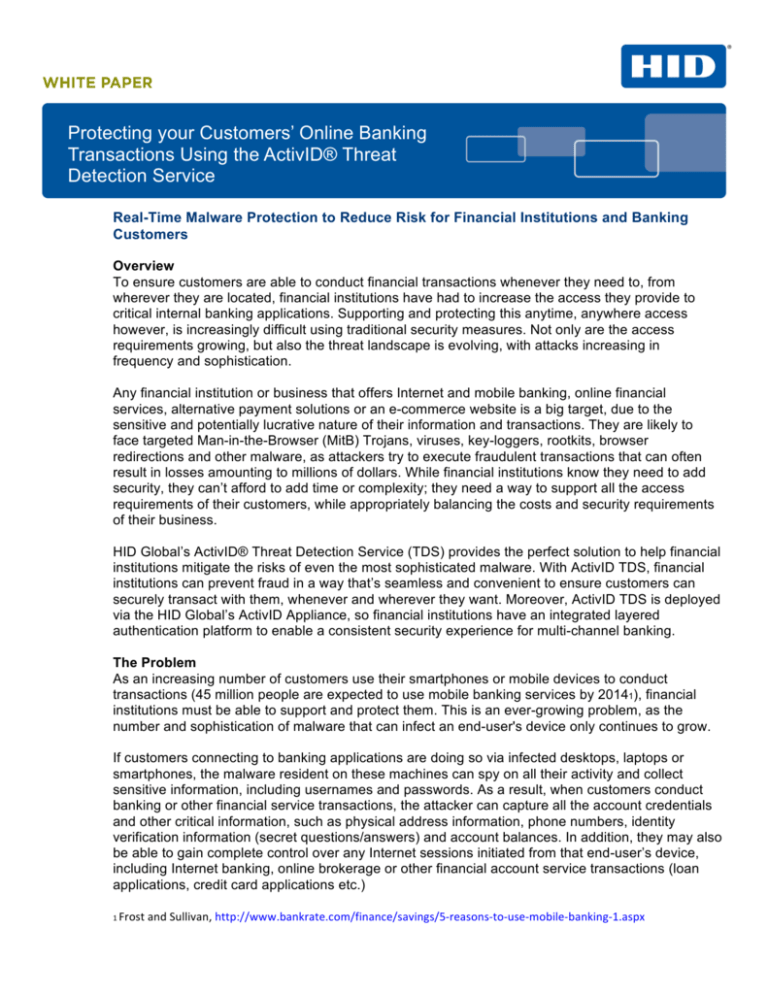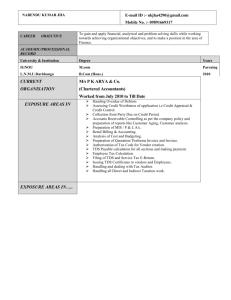
Protecting your Customers’ Online Banking
Transactions Using the ActivID® Threat
Detection Service
Real-Time Malware Protection to Reduce Risk for Financial Institutions and Banking
Customers
Overview
To ensure customers are able to conduct financial transactions whenever they need to, from
wherever they are located, financial institutions have had to increase the access they provide to
critical internal banking applications. Supporting and protecting this anytime, anywhere access
however, is increasingly difficult using traditional security measures. Not only are the access
requirements growing, but also the threat landscape is evolving, with attacks increasing in
frequency and sophistication.
Any financial institution or business that offers Internet and mobile banking, online financial
services, alternative payment solutions or an e-commerce website is a big target, due to the
sensitive and potentially lucrative nature of their information and transactions. They are likely to
face targeted Man-in-the-Browser (MitB) Trojans, viruses, key-loggers, rootkits, browser
redirections and other malware, as attackers try to execute fraudulent transactions that can often
result in losses amounting to millions of dollars. While financial institutions know they need to add
security, they can’t afford to add time or complexity; they need a way to support all the access
requirements of their customers, while appropriately balancing the costs and security requirements
of their business.
HID Global’s ActivID® Threat Detection Service (TDS) provides the perfect solution to help financial
institutions mitigate the risks of even the most sophisticated malware. With ActivID TDS, financial
institutions can prevent fraud in a way that’s seamless and convenient to ensure customers can
securely transact with them, whenever and wherever they want. Moreover, ActivID TDS is deployed
via the HID Global’s ActivID Appliance, so financial institutions have an integrated layered
authentication platform to enable a consistent security experience for multi-channel banking.
The Problem
As an increasing number of customers use their smartphones or mobile devices to conduct
transactions (45 million people are expected to use mobile banking services by 20141), financial
institutions must be able to support and protect them. This is an ever-growing problem, as the
number and sophistication of malware that can infect an end-user's device only continues to grow.
If customers connecting to banking applications are doing so via infected desktops, laptops or
smartphones, the malware resident on these machines can spy on all their activity and collect
sensitive information, including usernames and passwords. As a result, when customers conduct
banking or other financial service transactions, the attacker can capture all the account credentials
and other critical information, such as physical address information, phone numbers, identity
verification information (secret questions/answers) and account balances. In addition, they may also
be able to gain complete control over any Internet sessions initiated from that end-user’s device,
including Internet banking, online brokerage or other financial account service transactions (loan
applications, credit card applications etc.)
1 Frost and Sullivan, http://www.bankrate.com/finance/savings/5-­‐reasons-­‐to-­‐use-­‐mobile-­‐banking-­‐1.aspx 2
There are also attacks that target the browser, which have proven to be a highly effective way for
attackers to gain access to critical information and transactions. A MitB Trojan, for example, could
modify the content of a website or insert additional transactions into that site to collect valuable
information or conduct fraudulent transactions. It is virtually impossible for the end user to
distinguish which parts of the website are legitimate and which parts have been “infected” by the
MitB Trojan. In fact, the end user is almost never aware that the browser is compromised in the first
place. Two-factor authentication can’t protect against MitB Trojans because it is not the integrity of
the user that has been compromised, it’s the browser. The Zeus Trojan --the single most prolific
and high profile of the MitB Trojans - is still operating today despite it being well-understood
technology. This is due to its large distribution network of crimeware as a service. When any of
these attacks are successful, the financial institution and customer pay the price, spending time and
money to investigate and recover from the attack.
ActivID Threat Detection Service
To make it easy for financial institutions to add security, without adding complexity, HID Global‘s
ActivID TDS is optionally available with the HID Global’s ActivID Authentication solution to layer
advanced Device Identification and Malware Detection seamlessly to existing online services.
ActivID TDS is completely unobtrusive and does not interrupt the online experience for the financial
instutitions’ customers. The software as a service (SaaS) solution supports transparent
authentication, fraudulent device detection and malware detection to help protect online
transactions from even the most sophisticated web-based attacks. When combined with the
multitude choices of strong authentication methods for secure access and transaction verification
via SMS and email, financial institutions gain multi-layered authentication for their customers that is
foundationally sound to address the latest wave of financial threats, and enables them to comply
with heightened regulatory guidances, such as the FFIEC. ActivID TDS, in conjunction with the
ActivID Appliance, enables the easy deployment of the Five Layers for Online Security.
Five Layers for Online Security
Malware Detection
ActivID TDS delivers Malware Detection transparently: identifying malicious software on an online
banking customer’s devices and preventing it from stealing information or committing fraudulent
transaction activities. It detects and protects against web session manipulation, cookie hijacking
and MitB attacks, as well as web-attacks coming from any client device, whether it is from a PC,
Mac or mobile device.
ActivID TDS uses JavaScript to employ various techniques to detect the presence of malware on
the endpoint, including:
• Patented page fingerprinting techniques to detect any page modification in real-time.
• Tag-less device identification to create a unique fingerprint for a device for fraud detection
purposes.
3
•
Malware forensics to identify malware present on a device.
ActivID TDS operates completely in the background; it doesn’t require the customer to register or
download anything. Because it is based on web standards, the solution works on all browsers and
devices, including PC, Mac, iPad, iPhone, Android and Kindle devices.
This approach enables ActivID TDS to detect a compromised device used by a customer in the
most expansive way. It doesn’t matter whether it’s an ultra-sophisticated, highly targeted advanced
persistent threat (APT), adware or spyware on the end user’s devices -- ActivID TDS will be able to
detect it.
Using ActivID TDS, financial institutions can:
• Instantly determine whether they are being targeted by a MitB Trojan, including Zeus,
SpyEye, Carberp, Silon, Gozi, Torpig and many other known and yet-to-be discovered
attacks.
• Manage online security threats from many types of web-enabled devices.
• Protect customer data from identity theft and insecure transactions.
• Reduce costs of fraudulent transactions and data breaches.
• Make existing fraud prevention efforts more efficient and effective.
How ActivID TDS Works
HID Global’s ActivID TDS will not only detect the common MitB threats (e.g. from Zeus or SpyEye),
but also targeted attacks. It will alert on an infected computer trying to connect, as well as also
deliver the critical knowledge on how the endpoint is infected.
ActivID TDS can provide this level of protection because it employs a patented page fingerprinting
method, which can detect any kind of MitB Trojan instantly. ActivID TDS does not rely on blacklists
or the explicit knowledge (patterns/signatures) of a few, particular Trojans, which can leave
customers exposed to targeted and zero day attacks. Instead, it employs a “whitelist” approach.
ActivID TDS knows what the web page really looks like, so that if a Trojan (even an unknown or
unseen one) changes anything on that page, ActivID TDS will immediately see it and instantly alert
the financial institution in real-time.
By creating a unique fingerprint of the page structure on an end-user’s device, the ActivID
Appliance can verify the integrity of the device in real-time. It doesn’t matter whether the MitB
Trojan injects visible content elements, such as personal information:
Or, “invisible” content elements, such as malicious JavaScript elements:
4
ActivID TDS will identify and protect the financial institution and its customers from it.
ActivID® Threat Detection
1. User accesses the Bank’s Online Banking System
2. Online Banking System page loads with profiling tags (login or transaction pages)
3. Web page submits device profiling data silently to ActivID Threat Detection Service
4. User submits Online Banking Service form
5. Online Banking System requests authentication/verification of User
6. ActivID Appliance retrieves profiling data for User
7. ActivID Appliance processes authentication/verification with risk score and returns to Online Banking System
8. Online Banking System grants or denies access, or prompts for step-up authentication
As a true SaaS offering, there is no installation, no hidden costs, and no complex integration. To
take advantage of ActivID TDS, financial institutions, with the ActivID Appliance, only need to
include one HTML tag for the webpage they want to protect.
Conclusion
The risk levels of financial institutions and their customers are growing exponentially, due to highly
motivated attackers who are applying increasingly sophisticated and targeted attack techniques to
commit financial fraud. These attacks are compromising legitimate users’ desktops, laptops and
mobile devices in a way that circumvents the traditional customer identification mechanisms
deployed by financial institutions today, to steal information and conduct fraudulent transactions.
5
Financial institutions need to protect themselves from resident malware on their customers’ devices,
which tries to steal usernames, passwords, screenshots and other data to be used for financial
fraud, as well as attacks that infiltrate and hijack customer sessions through MitB and session
hijacking techniques. They need to get ahead of these sophisticated attacks to mitigate the risks to
their institution.
HID Global’s ActivID Authentication solution offers a coordinated, layered approach with the
ActivID TDS to prevent web-application and resident malware from stealing sensitive information
and conducting financial fraud. The unique features of ActivID TDS offer financial institutions an
essential defense against MitB Trojans, viruses, key-loggers, rootkits, browser redirections and
other malware, including zero-day and targeted attacks. Because ActivID TDS is deployed with
the ActivID Appliance, financial institutions gain a comprehensive security solution that holistically
delivers the necessary layers for true, multi-factor authentication to enable trusted online
transactions.
hidglobal.com
© 2014 HID Global Corporation/ASSA ABLOY AB. All rights reserved. HID, HID Global, the HID Blue Brick logo, the Chain Design are trademarks or registered trademarks of HID
Global or its licensor(s)/supplier(s) in the US and other countries and may not be used without permission. All other trademarks, service marks, and product or service names are
trademarks or registered trademarks of their respective owners. 2014-03-24-hid-actividtds-wp-en
PLT-01597


![Systems Assurance [Opens in New Window]](http://s3.studylib.net/store/data/007522633_2-e364c8f93e26286779d02c826b323ed6-300x300.png)




